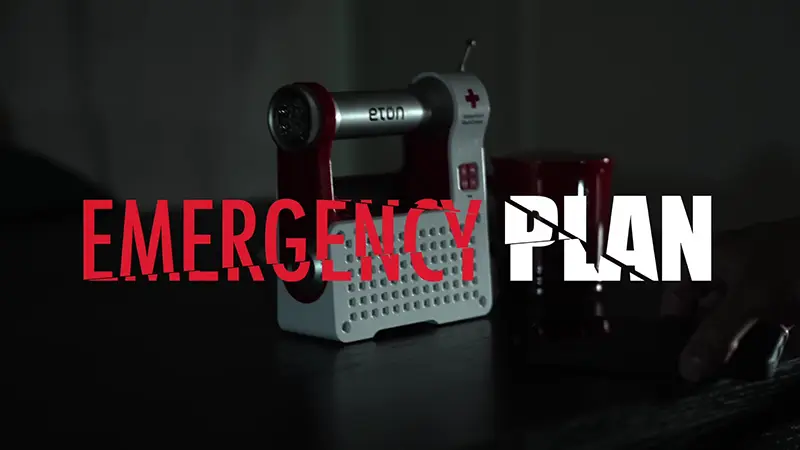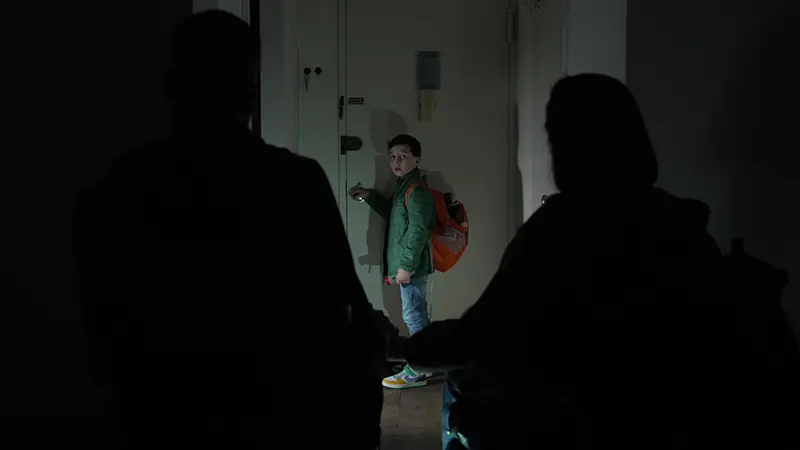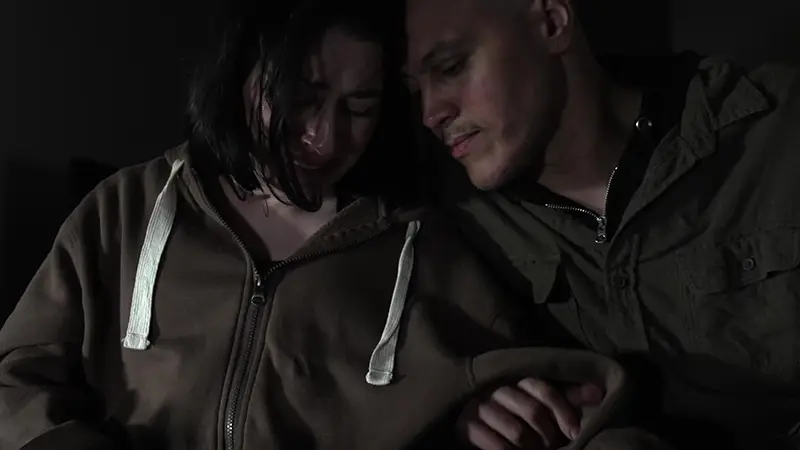Every filmmaker knows the pressure of a tight shoot – juggling locations, lighting, budgets, and logistics. Imagine doing it all while racing the clock, on a shoestring budget, in a tight New York City apartment, during a fictional city-wide emergency.
That was our reality on Emergency Plan, a short thriller made for the 2025 Easterseals Disability Film Challenge (EDFC), where filmmakers have exactly five days to write, shoot, and edit a 5-minute film.
 Courtesy of Annatated Productions
Courtesy of Annatated Productions
In the film, a disabled couple trapped in their high-rise apartment during a massive earthquake must make an unthinkable decision to save their young son, highlighting the inequities our community faces during emergencies, from natural disasters to pandemics and wars.
What made this project truly special wasn't just the subject matter. It was the team. Most of Emergency Plan's creative team, including our stars, cinematographer, and editor – and me as director – are wheelchair users. We didn't just tell a story about disability – we embodied it, behind and in front of the lens.
Working with a Cast that Reflects the Story
Our cast includes Margo Gignac, a quadriplegic actress who appeared in The Rookie, and James Ian, a musician and actor with spinal muscular atrophy and the voice behind the hit song "Spaces."
Their performances in Emergency Plan are heartbreakingly real because they've lived versions of this truth. They've faced inaccessibility, emergency plans that ignore their needs, and the quiet fear of being left behind in a crisis. Tony award winner Ali Stroker lends her talent to the project as the voice of the radio reporter who keeps the couple (and the audience) informed of the twists and turns of the disaster unfolding in the outside world.
Their son in the film, played by Charlie Steinman, who captured hearts in Broadway's Merrily We Roll Along, becomes the symbol of hope and of the heavy burden placed on children of disabled parents when systems fail. For disabled people, it's not just a story – it's a reflection of the painful reality they face far too often.
 Courtesy of Annatated Productions
Courtesy of Annatated Productions
We've all seen stories that portray disabled people as either pitiful victims or unlikely heroes. Emergency Plan avoids both tropes, instead leaning into true suspense: the question of "what would you do?" when there's no good option.
That question becomes even more urgent when you consider that over 39% of disabled people have significant difficulty evacuating during a disaster. Many live in housing that's not easy to evacuate. Emergency plans often exclude mobility, communication, or sensory accommodations. It's no surprise, then, that disabled people die in disasters at rates two to four times higher than nondisabled people – a disparity acknowledged by the United Nations.
 Courtesy of Annatated Productions
Courtesy of Annatated Productions
Why Representation Behind the Camera Matters
We often talk about authentic casting – and rightly so. The Ruderman Family Foundation has found that disabled roles are rarely played by disabled actors, even though disabled people make up a significant portion of the population. Meanwhile, non-disabled celebrities continue to receive critical acclaim for portraying disabled characters. But authentic storytelling goes deeper than who appears on screen, and representation behind the camera is even further behind. Just 1% of writers in Hollywood identify as people with disabilities, and those numbers are even smaller for directors and cinematographers.
In Emergency Plan, authenticity was embedded into every step of the filmmaking process.
As a disabled director, I bring my lived experience into every scene I shape. I understand how power dynamics shift in conversations about disability. I know what it means to be left behind – metaphorically and literally. I also know how to frame a shot for a seated actor in a way that feels natural while playing "wheelchair Tetris" to get the shot with four wheelchair users in a small space.
Our cinematographer, John Floresca, is a wheelchair user, too. The surfing accident that left him paralyzed didn't take any wind from his impressive résumé. A union camera assistant and active member of IATSE Local 600, Floresca has built a career pulling focus on a wide range of projects – from Jodie Foster's Money Monster to five years at Saturday Night Live's film unit. He primarily works as a first AC on The Daily Show. While shooting from a wheelchair presents challenges that other directors of photography may not face, Floresca also has unique advantages like a built-in dolly.
Our editor, Eric Velarde, also a wheelchair user, brought a nuanced eye to performance pacing. He let the silences breathe and know when to hold on an actor's face a second longer to let the emotion land.
The Reality of Shooting Accessibly
Let's be clear: filming with a wheelchair-user-heavy crew isn't "inspiring," but it does require some logistical foresight.
We shot Emergency Plan in a single location: my unicorn of an accessible New York City apartment. With modest, self-funded resources, we couldn't show the outside world on screen, so we turned to a War of the Worlds-style radio broadcast to suggest the unfolding disaster. Black garbage bags taped to the windows helped us recreate a city-wide blackout, while flashlights, battery-powered lanterns, cell phones, and the headlights on Gignac's wheelchair provided the film's eerie, practical glow.
We chose our equipment carefully. Our cinematographer shot on a Sony A7 iv with a Sony G series 24mm-70mm lens – gear that offered flexibility without being too bulky to manage independently while seated. We planned our blocking based on where wheelchair users could move comfortably on set, and we built the schedule around rest breaks and energy management – which, frankly, is something every production should prioritize.
A COVID testing regimen with at-home PCR quality Metrix tests offered peace of mind for all and accessibility for high-risk disabled cast and crew members.
Our production wasn't slowed down by access needs – it was enhanced because of them. We created space where everyone could do their best work.
The Future of Disability-Led Filmmaking
Emergency Plan isn't just a short film – it's a proof of concept. It proves that disabled filmmakers can lead, direct, shoot, and edit high-quality, emotionally resonant work on a tight timeline and budget. It proves that access isn't a burden – it's an advantage that encourages creativity and collaboration.
It proves that when disabled people are given the chance to tell our own stories, we bring more authenticity, empathy, and impact than any film made without us on the set and in the writers' room.
About the author
Anna Pakman is an award-winning writer, director, and producer. In addition to her passion for filmmaking, Anna is an expert digital marketer and serves as head of digital for New York State's I LOVE NY tourism campaign and business development initiatives. Prior to that, she spent several years in the television industry-leading award-winning social media campaigns for Current TV and Oxygen Network.
Anna received an MBA from Columbia Business School, a bachelor's degree from NYU, and completed the sketch program at the Upright Citizens Brigade Theater in NYC, where she resides.
Most of the stories here on LiveQuickie.com were submitted by readers. Do you have a story to tell? We'd love to hear it. Submit your story here.